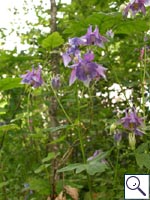|
||||||
|
AQUILEGIA. Columbine. [Ranunculaceae] |
|
|
Columbine (A. vulgaris) is the only native species of Aquilegia in Britain, although Pyrenean Columbine (A. pyrenaica) and other species have been introduced. Four British miners are recorded on Aquilegia. A key to the European miners recorded on Aquilegia is provided in Bladmineerders van Europa.
|
 Columbine Aquilegia vulgaris |
Key for the identification of the known mines of British |
1a > Stem-miner: Larva forms an external stem mine, with widely spaced grains of black frass. Pupation takes place at the end of the mine. Puparium black |
|
Ophiomyia aquilegiana Lundquist [Diptera: Agromyzidae]. |
1b > Leaf-miner |
2a > Leaf-miner: Larva forming short, irregular white linear mine, with frass in conspicuous black strips. Pupation external, normally adhering to the leaf near the end of the mine until dislodged by rain or wind (Spencer, 1972b: 83 (fig. 269B; Spencer, 1976: 381 (figs 663B), 450). A pale green, upper-surface, fairly broad, waving corridor; relatively short, up to 7 cm. Frass at first in grains, later in short thread fragments or pearl strings, at either side of the corridor. Often several mines in a leaf. Pupation outside the mine, exit slit in lower epidermis. A relatively broad, short upper surface gallery. Frass in conspicuous black stripes. |
|
Phytomyza minuscula Goureau, 1851 [Diptera: Agromyzidae]. |
2b > Leaf-miner: A large primary blotch, sometimes several larvae feeding together with frass scattered irregularly throughout the mine; leaves often being largely destroyed and the plants suffering considerable damage. Puparium dull brown. Striking, large, somewhat inflated, upper-surface, often purple-brown blotch without a preceding corridor. The mine is unusual because locally also the spongy mesophyl is eaten away, making the mine locally full depth and giving it a mottled appearance (right picture below). The mine begins in the centre of the leaf, or the base of a leaf segment (Griffiths, 1956b). The very first part of the mine differs in colour and structure; probably it is made by the larvae before its first ecdysis. Frass in very fine grains scattered over the floor of the mine. Pupation outside the mine. Exit slit in upper epidermis (Pakalniskis, 2004a). |
|
Phytomyza aquilegiae Hardy, 1849 [Diptera: Agromyzidae]. |
2c > Leaf-miner: In the first instar the larva mines the leaves, forming short, irregular, blotch-like mines, but in later instars it lives externally, feeding in spun leaves and often twisting those of tender shoots. Larval head light-brown or yellowish brown, edged with black postero-laterally, ocellar area blackish; prothoracic plate black edged with whitish anteriorly; abdomen dull dark green; pinacula distinct, black, sometimes brownish but with black bases to setae; anal plate large, black (Bradley et al., 1973). Small, full depth mine without a definite shape; little frass. Some silk is deposited in the mine. The larva soon leaves the mine and continues feeding among spun leaves. |
|
Cnephasia incertana (Treitschke, 1835) [Lepidoptera: Tortricidae]. |
| Last updated 30-Jun-2019 Brian Pitkin | ||
